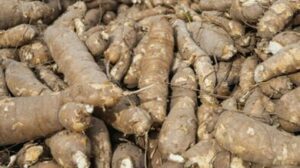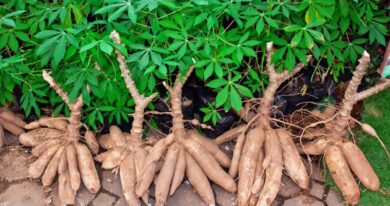Last updated on August 15, 2025
The best cassava varieties in Nigeria for high yields are TME 419, TMS 30572, TMS 98/0505, TMS 98/0581, and Vitamin A cassava—each with unique strengths for different markets and regions.
If you want to make real profit from cassava farming in Nigeria, your first big decision is simple but crucial: Which cassava variety should I plant? The truth is, the best cassava variety in Nigeria can double your yield, cut your losses from disease, and make your farm much more profitable.
I learned this hard way. My first year, I planted a local variety just because it was cheap and easy to get. My harvest was disappointing, and I lost a lot to cassava mosaic disease. The next season, I switched to an improved cassava variety (TME 419), and my yield nearly doubled—with less stress and fewer losses.
Expert insight: According to the International Institute of Tropical Agriculture (IITA), choosing the right variety can mean the difference between 10 tons and 30 tons per hectare. That’s a huge difference in your pocket. As Mercy Diebiru-Ojo, Vegetative Seed Specialist with IITA GoSeed, stated, “We have seen most improved varieties yield more than 30 tons per hectare, against the less than 10 tons farmers usually get from the old local varieties.” (Source: IITA News Item)
Tip: Don’t just plant what your neighbor is planting. Take time to choose the right variety for your soil, climate, and market.
For a full step-by-step guide, see How to Start Cassava Farming in Nigeria.
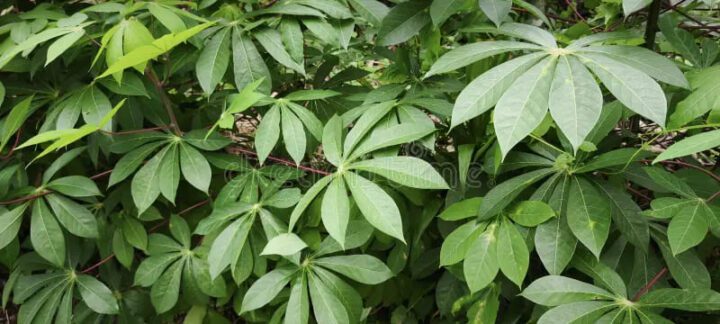
What Are the Main Types of Cassava Varieties in Nigeria?
There are two main types of cassava varieties you’ll find in Nigeria:
- Improved Cassava Varieties: These are developed by research institutes like IITA and NRCRI. They are bred for high yield, disease resistance, and faster maturity. Examples include TME 419, TMS 30572, and Vitamin A cassava.
- Local Cassava Varieties: These are traditional types, often preferred for taste or specific uses, but usually have lower yields and are more vulnerable to diseases.
Why improved varieties matter: They are designed to solve real farmer problems—like cassava mosaic disease, low yield, and late maturity. As Dr. Kwesi Atta-Krah, Emeritus Director of Country and Regional Engagement at IITA, aptly puts it, improved varieties are “‘Local varieties’ that have ‘stuff built into them’ to enhance their performance in the field. That is why they are called improved varieties.” (Source: IITA News Item)
Advice: If you want to maximize your profit and reduce risk, always go for improved, disease-resistant cassava varieties.
What Are the Top 5 Best Cassava Varieties in Nigeria (2025)?
1. TME 419
If you ask most commercial cassava farmers in Nigeria about their favorite variety, TME 419 will come up again and again—and for good reason. This variety is a true game-changer. It’s not just about the numbers (though the yield can reach up to 30 tons per hectare if you manage your farm well). What really sets TME 419 apart is its reliability. Even in a tough year, with unpredictable rain or a sudden pest outbreak, TME 419 holds its own.
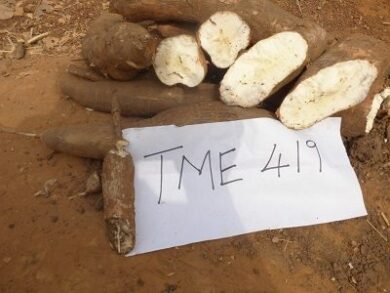
From my own experience, TME 419 is a forgiving variety. I’ve had seasons where I couldn’t weed as often as I wanted, or where the rains came late, and this cassava still produced strong, healthy roots. It’s also one of the best for garri—the roots are big, easy to peel, and have a high dry matter content, which means more garri per bag of cassava. Buyers in the market know and trust TME 419, so it’s easier to sell, and you’ll often get a better price.
Expert insight: TME 419 is highly resistant to cassava mosaic disease and cassava bacterial blight, two of the biggest threats to cassava farmers in Nigeria. It matures in about 12 months, so you can plan your harvest and cash flow with confidence.
Best for: Farmers who want high yield, disease resistance, and a variety that’s easy to sell for garri, fufu, or flour.
Quick facts:
- Yield: Up to 30 tons/ha (one of the highest in Nigeria)
- Maturity: 12 months
- Disease resistance: Excellent (especially against mosaic and bacterial blight)
- Best for: Garri, fufu, flour
- Personal insight: When I switched to TME 419, my harvest almost doubled, and buyers loved the quality for garri.
2. TMS 30572
TMS 30572 is a classic for a reason. It’s been around for years, and many farmers still swear by it. What I love about this variety is its adaptability. Whether you’re farming in the North, South, or anywhere in between, TMS 30572 seems to thrive. It’s not as flashy as some of the newer varieties, but it’s dependable—think of it as the Toyota Corolla of cassava.
One thing that stands out is its early maturity. If you’re in a hurry to harvest or need to rotate your land quickly, TMS 30572 can be ready in as little as 12 months, though some farmers leave it for up to 15 months for even bigger roots. The roots are uniform and easy to process, making it a favorite for both small-scale and commercial processors.
Expert tip: TMS 30572 is also known for its high dry matter, which is great for garri and flour. It’s not as resistant to every disease as TME 419, but it holds up well in most conditions and is less likely to disappoint you at harvest.
Best for: Farmers who want a tried-and-true variety that works almost anywhere and is easy to process and sell.
Quick facts:
- Yield: 25–28 tons/ha
- Maturity: 12–15 months
- Disease resistance: Very good
- Best for: Garri, flour, industrial use
- Expert tip: This variety is reliable and does well in most parts of Nigeria.
3. TMS 98/0505
If you’re looking to supply the growing market for cassava flour or industrial starch, TMS 98/0505 is a variety you should seriously consider. This is a fast-growing, high-yielding cassava that’s been bred specifically for its starch content and processing qualities.
What makes TMS 98/0505 unique is its tolerance to cassava mosaic disease—a big plus if you’re farming in an area where this disease is a problem. The roots are long and thick, and they store well in the ground, so you don’t have to rush your harvest. I’ve seen processors pay a premium for TMS 98/0505 because it gives them more flour per ton of roots.
Personal insight: I once planted TMS 98/0505 on a plot that had struggled with disease in the past. Not only did it survive, but it also outperformed my expectations, especially in terms of root size and weight.
Best for: Farmers targeting the flour or starch market, or those who want a disease-tolerant, high-yield variety.
Quick facts:
- Yield: 22–26 tons/ha
- Maturity: 12 months
- Disease resistance: Tolerant to mosaic disease
- Best for: Flour, industrial starch, animal feed
4. TMS 98/0581
TMS 98/0581 is a bit of a hidden gem. It’s not as widely planted as TME 419 or TMS 30572, but those who know it, love it—especially for garri and fufu. This variety is known for its high starch content and the quality of its processed products. If you’re selling to local processors or want to make your own garri or fufu, TMS 98/0581 is a strong choice.
One thing I’ve noticed is that TMS 98/0581 is very resilient. It handles pest pressure well and doesn’t seem to mind if the weather isn’t perfect. The roots are chunky and easy to harvest, and the taste of the final product is often praised by buyers.
Expert insight: TMS 98/0581 is a good option if you want to diversify your farm or if you’re in an area where pests have been a problem in the past.
Best for: Farmers focused on local processing, especially for garri and fufu, and those who want a variety that can handle tough conditions.
Quick facts:
- Yield: 20–25 tons/ha
- Maturity: 12–15 months
- Disease resistance: Strong against pests and diseases
- Best for: Garri, fufu (high starch content)
5. Vitamin A (Yellow) Cassava
The rise of Vitamin A cassava (sometimes called yellow cassava) is one of the most exciting trends in Nigerian agriculture. Developed by IITA and other research bodies, this variety is biofortified to help fight vitamin A deficiency—a real health issue in many parts of Nigeria.
But it’s not just about nutrition. Vitamin A cassava is also a solid performer in the field, with yields of 20–24 tons per hectare and good resistance to common diseases. The roots are yellow (not white), which some buyers now prefer, especially for fufu and certain types of garri. In my experience, yellow cassava is a conversation starter at the market—people are curious, and some are willing to pay more for the health benefits.
Expert tip: If you’re farming near urban centers or supplying schools and health-focused buyers, Vitamin A cassava can give you a marketing edge. It matures in about 12–14 months and is fairly easy to manage.
Best for: Farmers who want to tap into the growing demand for healthier, value-added cassava products, or who want to make a difference in their community’s nutrition.
Quick facts:
- Yield: 20–24 tons/ha
- Maturity: 12–14 months
- Disease resistance: Good
- Best for: Fufu, garri, and health-conscious markets (rich in Vitamin A)
- Market tip: Yellow cassava is gaining popularity for its health benefits and fetches a premium price in some markets.
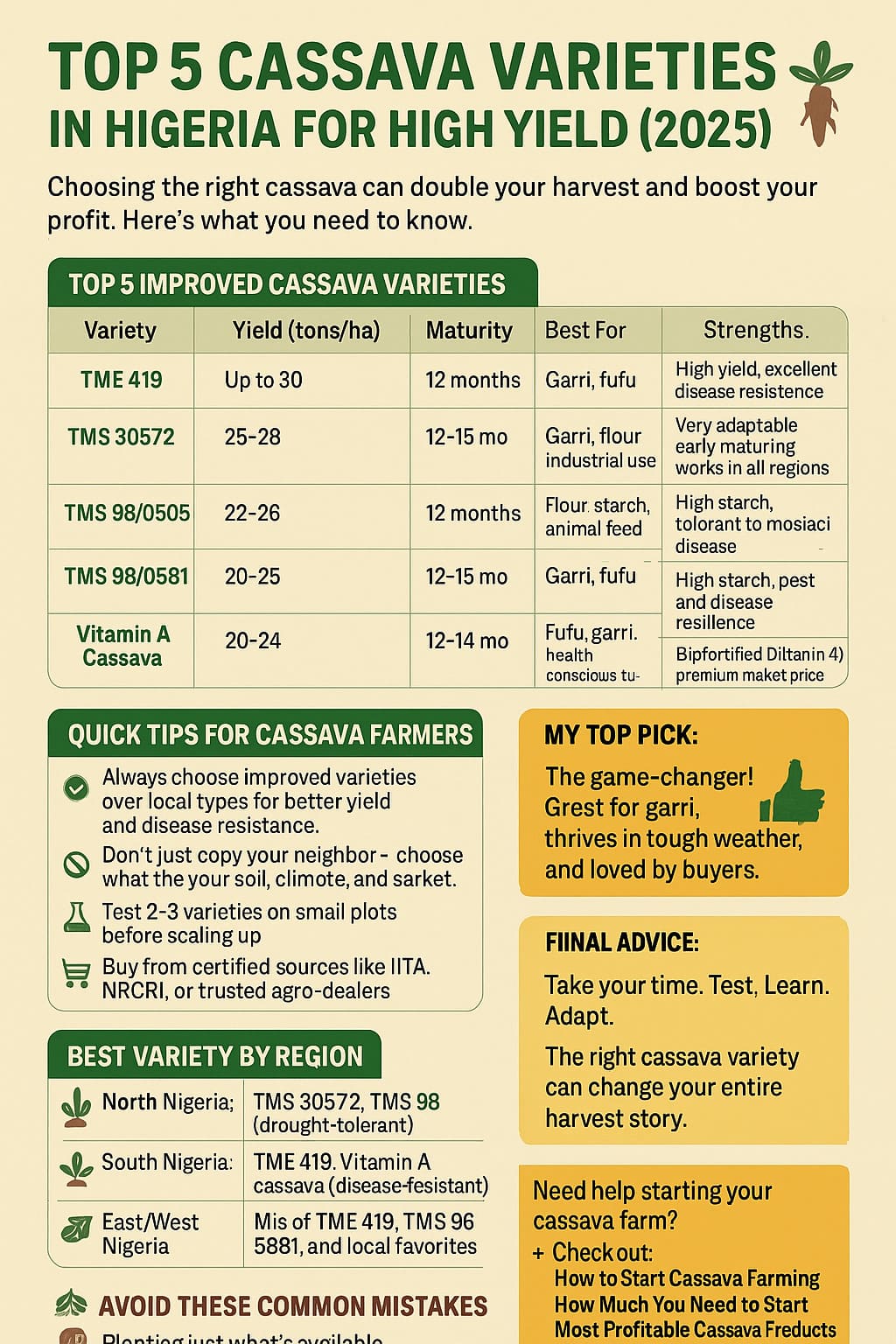
Cassava Variety Comparison Table
| Variety | Yield (tons/ha) | Maturity (months) | Disease Resistance | Best For | Special Notes |
|---|---|---|---|---|---|
| TME 419 | Up to 30 | 12 | Excellent (mosaic, blight) | Garri, fufu, flour | Market favorite, reliable in tough seasons |
| TMS 30572 | 25–28 | 12–15 | Very good | Garri, flour, industrial use | Adaptable, early maturing, works in most regions |
| TMS 98/0505 | 22–26 | 12 | Tolerant to mosaic disease | Flour, industrial starch, animal feed | High starch, stores well in ground |
| TMS 98/0581 | 20–25 | 12–15 | Strong against pests and diseases | Garri, fufu (high starch content) | Resilient, praised for taste and processing |
| Vitamin A Cassava | 20–24 | 12–14 | Good | Fufu, garri, health-conscious markets | Yellow roots, fetches premium price, biofortified |
Final advice: No single variety is perfect for every farm. The best cassava variety in Nigeria for you depends on your soil, climate, market, and even your personal goals as a farmer. If you can, try planting two or three varieties on small plots first. Watch how they perform, talk to buyers, and then scale up with the one that works best for you.
How to Choose the Best Cassava Variety for Your Farm?
Choosing the best cassava variety in Nigeria isn’t just about picking the highest yield. Here’s what you should consider:
- Soil type: Some varieties do better in sandy soils, others in loamy or clay soils.
- Rainfall and climate: If you’re in a dry area, pick drought-tolerant types like TMS 30572.
- Disease pressure: If your area has a history of mosaic or blight, go for TME 419 or TMS 98/0581.
- Market demand: What do buyers in your area want? For example, some markets pay more for yellow cassava or varieties that make good garri.
How-to:
- Ask your local extension officer for advice.
- Test a small plot with 2–3 varieties before planting your whole farm.
- Talk to other successful farmers in your area.
Personal tip: I once planted a variety that was great for flour, but my local market only wanted garri. I had to sell at a loss. Always check what your buyers want before you plant.
Where to Buy Certified Cassava Stem Cuttings in Nigeria?
Getting certified cassava cuttings is one of the most important steps for a successful farm.
Trusted sources:
- IITA (International Institute of Tropical Agriculture)
- NRCRI (National Root Crops Research Institute)
- Reputable agro-dealers and local extension offices
How to avoid fake or diseased cuttings:
- Only buy from certified sources.
- Check for healthy, green stems (no black spots, not wilted).
- Ask for proof of certification if possible.
Personal story: I once bought “cheap” cuttings from a roadside seller—half didn’t sprout. Lesson learned: always buy from trusted sources.
For a full cost breakdown, see How Much Do I Need to Start a Cassava Farm?
What Are the Best Cassava Varieties for Garri, Fufu, and Flour?
- Best for Garri: TME 419, TMS 30572, TMS 98/0581 (high dry matter, good swelling)
- Best for Fufu: TME 419, Vitamin A cassava (smooth texture, good taste)
- Best for Flour: TMS 98/0505, TMS 30572 (high starch, easy to process)
Market tip: Yellow cassava is gaining popularity for its health benefits and can fetch a higher price, especially for fufu.
For more on cassava processing and maturity, see How Long Does It Take Cassava to Grow?
Region-Specific Recommendations: Which Cassava Varieties are Best by State/Zone?
- North: Drought-tolerant, early-maturing (TMS 30572, TMS 98/0505). For example, a farmer in Kano State reported that TMS 30572 consistently yielded well even during shorter rainy seasons.
- South: High-yield, disease-resistant (TME 419, Vitamin A cassava). In Akwa Ibom, a cooperative saw a 30% increase in their collective yield by switching to TME 419 due to its excellent disease resistance in humid conditions.
- East/West: Mix of TME 419, TMS 98/0581, and local favorites. A farmer in Enugu State found that TMS 98/0581 produced exceptionally high-quality fufu, leading to better market prices from local buyers.
Mini-case study: A farmer in Ogun State switched from a local variety to TME 419 and saw his yield jump from 10 to 25 tons per hectare. He also spent less on chemicals and got a better price for his garri.
For best planting times, see Best Month to Plant Cassava in Nigeria
What Are the Common Mistakes When Choosing Cassava Varieties (and How to Avoid Them)?
- Planting only what’s available: Don’t just use what’s easy to get—choose what’s best for your farm and market.
- Ignoring local extension advice: Extension officers know what works in your area.
- Not checking for disease resistance: This can cost you your entire harvest.
- Not considering market demand: Always ask buyers what they want.
Expert advice: Always ask for a demo plot or farmer testimonials before buying new varieties.
For more lessons, see How Profitable is Cassava Farming in Nigeria?
Frequently Asked Questions (FAQs) About Cassava Varieties in Nigeria
What is the highest yielding cassava variety in Nigeria?
TME 419 is currently the top choice for yield and disease resistance.
Which cassava is best for garri?
TME 419, TMS 30572, and TMS 98/0581 are all excellent for garri.
How do I know if my cuttings are disease-free?
Buy from certified sources, check for healthy, green stems, and avoid wilted or black-spotted cuttings.
Can I mix varieties on my farm?
Yes, and it can help spread risk and meet different market needs.
Summary & Key Takeaways
- The best cassava variety in Nigeria depends on your location, soil, and market.
- Improved varieties like TME 419 and TMS 30572 offer high yields and strong disease resistance.
- Always buy certified cassava cuttings and consult local experts before planting.
- Don’t be afraid to try new varieties on a small scale before going big.
Conclusion
Choosing the best cassava variety in Nigeria is one of the smartest decisions you can make as a farmer. It’s not just about chasing the highest yield—it’s about picking a variety that fits your land, your climate, and your market. From my own experience, switching to an improved, disease-resistant variety like TME 419 made a huge difference in both my harvest and my peace of mind.
My advice? Don’t rush your decision. Talk to local extension officers, visit other farms, and if possible, test a few varieties on a small plot before you go all in. Always buy certified cassava cuttings from trusted sources, and keep an eye on what buyers in your area actually want.
Remember, the right variety can mean the difference between a struggling farm and a thriving one. Take your time, do your research, and don’t be afraid to try something new. Your future self—and your bank account—will thank you.
If you’re ready to take the next step, check out my other guides on how to start cassava farming, how much you need to start, and how to maximize your profit.
Wishing you a bountiful harvest!
